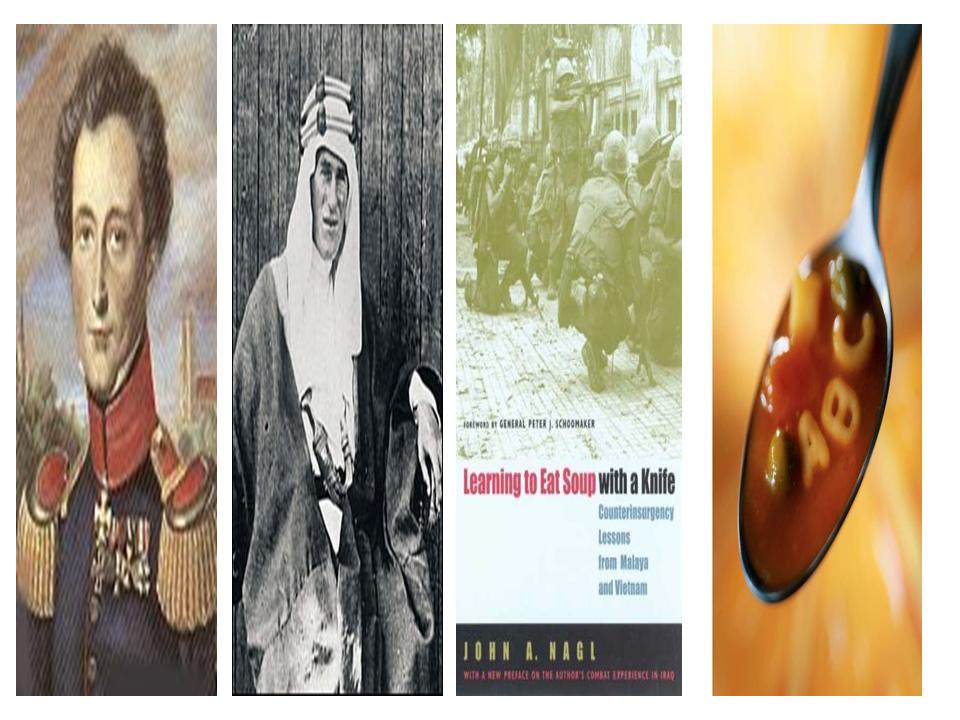Jan.27.2010
12:22 pm
by Ed Beakley
EEI#27 “What kind of War?” – First Addendum – The Post-COIN Era is Here
Making war upon insurgents is messy and slow, like eating soup with a knife. T.E. Lawrence

In a new think piece, one of the best writer/thinkers on line, Mark Safranski at Zenpundit in “The Post-COIN Era is Here; Learning to eat Soup with a Spoon Again” -provides not only more detail on the COIN (“or not”) debate and its significance (real or imaginary), but also gives serious thought to the possible fallout, noting the following:
- … to father a doctrine does not mean that you can control how others interpret and make use of it.
- COIN is an excellent operational tool, brought back by John Nagl & co. (Learning to Eat Soup with a Knife: Counterinsurgency Lessons from Malaya and Vietnam) from the dark oblivion that Big Army partisans consigned it to cover up their own strategic failures in Vietnam. As good as COIN is though, it is not something akin to magic with which to work policy miracles or to substitute for America not having a cohesive and realistic grand strategy.
- We are all COINdinistas now. Instead of being controversial, COIN having a secure place in our operational arsenal of ideas has become the new ”conventional” wisdom; it is past time to look at some of the other serious challenges America has ahead.
The Post-COIN article has received significant discussion on other blogs, critical review, and comment including from author of The Pentagon’s New Map, Thomas P.M. Barnett. One line of reasoning introduced by Barnett is the degree to which COIN and the debate and decisions have impact on the larger defense and security issues facing DOD and the nation.
In preliminary articles (EEI’s #6, #7, #10) to the “what kind of war” series, the point was made that as we move in time from 9-11, the force structure and technical direction decisions made by and for DOD will impact decisions on risk mitigation, risk management, and level of risk acceptance that the homeland security, public safety and first responder organizations nation-wide will have left on their plate. Understanding these issues, it would seem then , is essential and critical for citizens, private sector and local government alike. In that sense, to what degree counter insurgency, COIN, is considered method, tactic, tool or core to strategic thinking has significant ramifications -
Gates is attempting to change not just what the Pentagon is buying, but its fundamental understanding of what it is procuring weapon systems for and why. Cold War-era weapons with such focused utility as the F-22 are not what he believes the Pentagon needs with an uncertain future… Gates is attempting a more fundamental reorientation of the entire Pentagon, with greater emphasis on the current campaigns in Iraq and Afghanistan, ‘hybrid wars’ and ‘fourth-generation’ warfare. (STRATFOR analysis on the F-22 decision)
Whether our propensity to engage in world situations requiring COIN is effected by how we consider COIN is debatable, but the degree to which we modify force structure, pursue or not emerging technology, and prepare for a future that appears to have a significant portion defined by the confrontation-conflict model – war amongst the people – should be of great interest to all. Several commenters ended with reflection back to vonClausewitz’s direction to determine the kind of war. The level and detail of the COIN discussion seems to highlight our inability or unwillingness to address von Clausewitz’s question.
Please read the original AND the comments: The Post-COIN Era is Here by Mark Safranski.
Filed in 4GW,Elements of Essential Information,What Kind of War,What Kind of War The Series | Comments Off
